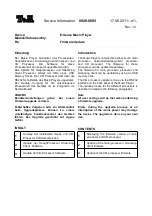
5
USA
Federal Communications Commission Statement
FCC Compliance Statement
Interference
This device complies with Part 15 of the FCC Rules.
Operation is subject to the following two conditions: (1)
This device may not cause harmful interference, and (2)
This device must accept any interference received, including
interference that may cause undesired operation
This equipment has been tested and found to comply with
the limits for a Class B digital device, pursuant to Part 15
of the FCC Rules. These limits are designed to provide
reasonable protection against harmful interference in a
residential installation. This equipment generates, uses,
and can radiate radio frequency energy and, if not installed
and used in accordance with the instructions, may cause
harmful interference to radio communications. However,
there is no guarantee that interference will not occur in a
particular installation. If this equipment does cause harmful
interference to radio or television reception, which can be
determined by turning the equipment off and on, the user is
encouraged to try to correct the interference by one of the
following measures:
• Reorient or relocate the receiving antenna.
• Increase the separation between the equipment and
receiver.
• Connect the equipment into an outlet on a circuit different
from that to which the receiver is connected.
• Consult the dealer or an experienced radio/TV technician
for help.
PRECAUTIONS
Notes on handling
Notes on locating
• When shipping the unit, the original shipping carton
and packing materials come in handy. For maximum
protection, repack the unit as it was originally packed at
the factory. Take care not to give it a shock or shake when
carrying.
• Do not use volatile liquids, such as insect spray, near the
unit. Do not leave rubber or plastic products in contact
with this unit for a long time. They will leave marks on the
finish.
• The top and rear panels of the unit may become warm
after a long period of use. This is not a malfunction.
• When the unit is not in use, be sure to remove the disc
and turn off the power.
• If you do not use the unit for a long period, the unit may
not function properly in the future. Turn on and use the
unit occasionally.
Place the unit on a level surface. Do not use it on a shaky
or unstable surface such as a wobbling table or inclined
stand. The loaded disc may come off the proper position
and cause damage to the unit.
When you place this unit near a TV, radio, or VCR, the
playback picture may become poor and the sound may
be distorted. In this case, place the unit away from the TV,
radio, or VCR.
Do not use this unit in places which are extremely hot, cold,
dusty or humid.
Do not restrict the air flow of this unit by placing it
somewhere with poor air flow, by covering it with a cloth,
or by placing it on bedding or carpeting.
Be sure to remove the disc and unplug the AC power cord from
the outlet before carrying the unit.
• For stubborn dirt, soak the cloth in a weak detergent
solution, wring well and wipe. Use a dry cloth to wipe it
dry. Do not use any type of solvent, such as thinners and
benzene, as they may damage the surface of the unit.
• If you use a chemical saturated cloth to clean the unit,
follow that product’s instructions.
Inspection and Maintenance
Notes on cleaning
This unit is a high technology, precision device. If the
optical pick-up lens and disc drive parts become dirty or
worn down, the picture quality may be reduced. To avoid
reduction in picture quality, it is recommended that regular
inspection and maintenance (cleaning or parts replacement)
be performed every 1,000 hours of use. For further details,
contact your nearest consumer electronics dealer.
Use a soft, dry cloth for cleaning.
Notes on moisture condensation
Moisture condensation damages the Toshiba Blu-ray
Disc™/DVD Player. Please read the following carefully:
• Moisture condensation occurs, for example, when you
pour a cold drink into a glass on a warm day.
• Drops of water form on the outside of the glass.
• In the same way, moisture may condense on the optical
pick-up lens inside this unit, one of the most crucial
internal parts of the unit.
Moisture condensation occurs during the following
cases.
• When you bring the unit directly from a cold place to a
warm place.






































